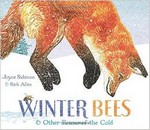 Winter Bees and Other Poems of the Cold
Winter Bees and Other Poems of the Cold Joyce Sidman
Illustrated by Rick Allen
Poetry Picture Book
For ages 6 and up
Houghton Mifflin Harcourt, 2014, 978-0-547-90650-8
In the past, winter was often a time of hardship for humans. Food was scarce, it was cold even indoors, sickness was common, and the days were short. Without the comforts of heated homes, electric lights, decent healthcare, and grocery stores, winter was grim. For wild animals winter is still a time of hardship. They have to adapt to the changes in their environment so that they can survive until spring.
In this award winning picture book Joyce Sidman shows us how animals that live in cold places survive, how they find ways to get through the long winter months. On every spread we find a richly textured and colored illustration that is with paired with a poem. There is also a section of nonfiction text, which provides us with further information about the animal species featured on the pages.
The first spread takes us into the cold world of the tundra swan. We see how they “tucked beaks / into feathers and settled for sleep.” As they slept, the swans dreamed of the journey that was coming when they would see “the sun’s pale wafer / the crisp drink of clouds. “ When the swans woke up to a land covered with snow, they began that journey that would take them thousands of miles from Alaska to warmer climes on the east or west coasts of the United States.
Later in the book we meet a young moose, a creature that is “built for the cold.” The largest deer species in the world, the moose’s size makes it possible for their core to stay warm and their “tough, shaggy hide” keeps their extremities from getting too cold. Moose use their excellent sense of smell to find food and they can reach the high branches of “willow and yew” that other animals cannot get to.
Beavers find the perfect way to get through winter. They build a dam and a lodge and even when their pond or lake freezes over, the beavers can swim under the ice to get to the twigs that they stashed in the water not far from their home. Like “strong brown bullets” they dive and then return to their warm home where they groom, eat, and then sleep cuddled up together.
Even the trees and plants have adapted to survive the cold darkness of winter. Deciduous trees shed their leaves and “essentially shut down” in winter, bending “when all the wild winds blow,” standing firm thanks to their deep root systems. Unlike the tender leaves of these trees, conifers have tough needles that are not damaged by freezing temperatures.
This is a book that children and adults will greatly enjoy exploring. The sections of text that appear on every spread are packed with fascinating facts and information, and the poems, with their layers of rich imagery and language, are a joy to read.

